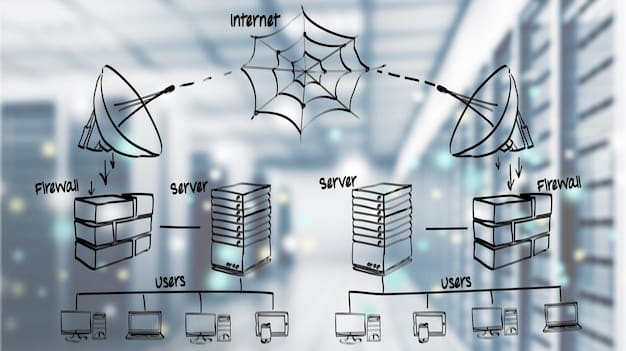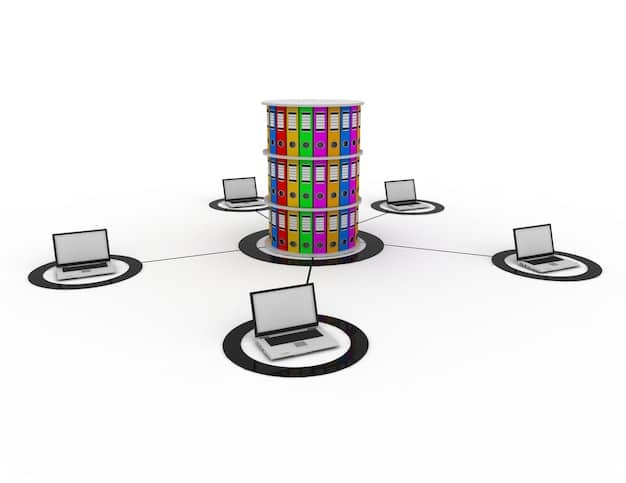Federated Learning vs. Centralized Learning: AI Model Development in 2025

In 2025, the key differences between federated learning and centralized learning for AI model development will revolve around data privacy, model accuracy, computational resources, and real-time adaptability, impacting how AI solutions are deployed and scaled.
As we move closer to 2025, the landscape of AI model development is becoming increasingly complex. The choice between federated learning and centralized learning is no longer a simple technical decision but a strategic one, closely tied to data privacy regulations, computational resources, and the need for real-time adaptability. Understanding the key differences between federated learning and centralized learning for AI model development in 2025 is crucial for businesses aiming to leverage AI effectively and responsibly.
Understanding Centralized Learning
Centralized learning is the traditional approach to AI model development, where data from various sources is gathered and stored in a central location. This centralized dataset is then used to train a machine learning model. While straightforward, this method presents challenges in the age of stringent data privacy regulations and increasing data volumes.
In a centralized learning environment, data scientists and machine learning engineers have direct access to all the data, which can speed up the model development process. However, this also means that the system is vulnerable to data breaches and privacy violations. Let’s examine the pros and cons more closely.
Advantages of Centralized Learning
Centralized learning offers several advantages, especially when computational resources are limited or data privacy isn’t a primary concern.
- Simplicity: The setup and implementation of centralized learning are generally simpler than federated learning.
- Efficiency: With all data in one place, training can be faster and more efficient.
- Control: Data scientists have full control over the data and the training process, allowing for more precise tuning and optimization.
Disadvantages of Centralized Learning
Despite its advantages, centralized learning has significant drawbacks that become more pronounced in 2025.
- Privacy Risks: Centralizing data increases the risk of data breaches and privacy violations.
- Scalability Issues: As data volumes grow, central storage and processing become bottlenecks.
- Regulatory Compliance: Complying with data privacy regulations like GDPR and CCPA becomes more challenging.

In conclusion, while centralized learning offers simplicity and control, its inherent privacy risks and scalability issues make it less suitable for many AI applications in 2025, especially those dealing with sensitive user data or requiring real-time, distributed processing.
Exploring Federated Learning
Federated learning, on the other hand, is a decentralized approach where machine learning models are trained across a network of devices or servers without exchanging raw data. Instead, each device trains the model locally, and only model updates are shared with a central server for aggregation. This approach enhances data privacy and reduces the need for massive data transfers.
Federated learning is particularly useful in scenarios where data is distributed across numerous devices, such as smartphones, IoT devices, or edge servers. This approach allows AI models to be trained on vast amounts of data while preserving user privacy. Let’s delve into some key aspects of federated learning.
How Federated Learning Works
The process of federated learning typically involves the following steps:
- A central server distributes an initial model to a subset of participating devices.
- Each device trains the model locally using its own data.
- The devices send their model updates back to the central server.
- The central server aggregates the updates to create a new global model.
- This process is repeated iteratively until the global model converges.
Benefits of Federated Learning in 2025
Federated learning offers several benefits that make it an attractive alternative to centralized learning in 2025.
- Enhanced Privacy: Data remains on the device, minimizing the risk of data breaches and privacy violations.
- Improved Scalability: Training is distributed across multiple devices, reducing the load on central servers.
- Regulatory Compliance: Easier to comply with data privacy regulations as data doesn’t need to be transferred or stored centrally.

In summary, federated learning provides a more privacy-conscious and scalable approach to AI model development. Its ability to train models on distributed data without centralizing it makes it a valuable tool in 2025, particularly in industries dealing with sensitive information or large-scale IoT deployments.
Data Privacy and Security
Data privacy and security are paramount concerns in AI model development, especially with increasingly stringent regulations. The fundamental difference between federated learning and centralized learning lies in how they address these concerns. Centralized learning involves consolidating data in one place, making it a target for potential breaches. Federated learning, on the other hand, keeps data decentralized, reducing this risk significantly.
In 2025, businesses will need to prioritize data privacy to maintain customer trust and comply with regulations like GDPR and CCPA. Understanding the nuances of how each approach handles data privacy is crucial for making informed decisions.
Centralized Learning and Privacy Risks
Centralized learning inherently poses greater privacy risks due to the concentration of data. Some of these risks include:
- Data Breaches: A single data breach can expose sensitive information from multiple sources.
- Insider Threats: Employees with access to the central data repository could potentially misuse or leak data.
- Regulatory Non-Compliance: Failure to adequately protect centralized data can result in hefty fines and legal repercussions.
Federated Learning and Privacy Preservation
Federated learning is designed to mitigate these risks by keeping data on the edge devices. This decentralized approach offers several privacy benefits:
- Data Localization: Data stays on the user’s device, reducing the risk of large-scale breaches.
- Differential Privacy: Techniques like differential privacy can be applied to model updates to further protect individual data points.
- Secure Aggregation: Model updates are aggregated in a secure manner, preventing individual contributions from being identified.
In conclusion, federated learning provides a more robust approach to data privacy and security in 2025. By keeping data decentralized and employing privacy-enhancing technologies, it minimizes the risk of data breaches and helps organizations comply with increasingly stringent data privacy regulations.
Model Accuracy and Performance
Model accuracy and performance are critical metrics in AI model development. While centralized learning has traditionally been favored for its ability to achieve high accuracy due to direct access to all data, federated learning is rapidly catching up with advancements in algorithms and techniques. Understanding the trade-offs between these approaches is essential for making informed decisions.
In 2025, the choice between federated learning and centralized learning will depend on the specific application, the quality and distribution of data, and the available computational resources. Let’s take a closer look at how each approach impacts model accuracy and performance.
Centralized Learning: Accuracy and Limitations
Centralized learning has historically been associated with higher model accuracy. However, this advantage comes with limitations:
- Data Homogeneity: Centralized learning assumes that the data is homogeneous and representative of the entire population, which may not always be the case.
- Data Quality: The accuracy of the model depends heavily on the quality of the centralized data.
- Overfitting: Models trained on centralized data can sometimes overfit to the specific characteristics of the dataset, leading to poor generalization on new data.
Federated Learning: Bridging the Accuracy Gap
Federated learning has made significant strides in improving model accuracy and performance:
- Algorithm Advancements: New federated learning algorithms are designed to handle non-IID (non-independent and identically distributed) data, which is common in distributed environments.
- Personalization: Federated learning can be combined with personalization techniques to tailor models to individual users or devices.
- Data Augmentation: Techniques like data augmentation can be used to improve the diversity and quality of local datasets.
In summary, while centralized learning may still hold a slight edge in certain scenarios, federated learning is rapidly closing the gap in model accuracy and performance. With advancements in algorithms and techniques, federated learning is becoming a viable option for a wide range of AI applications in 2025.
Computational Resources and Infrastructure
Computational resources and infrastructure play a crucial role in AI model development. Centralized learning requires powerful central servers to process large datasets, while federated learning leverages the computational capabilities of distributed devices. The choice between these approaches depends on the available resources and the specific requirements of the application.
In 2025, the increasing availability of edge computing resources is making federated learning more attractive, especially for applications that require low latency and real-time processing. Let’s compare the resource requirements of centralized learning and federated learning.
Centralized Learning: High Resource Demands
Centralized learning typically requires significant computational resources and infrastructure:
- Powerful Servers: Training large models requires high-performance servers with ample CPU, GPU, and memory.
- Scalable Storage: Centralized data storage needs to be scalable to accommodate growing datasets.
- Network Bandwidth: Transferring large datasets to the central server requires high network bandwidth.
Federated Learning: Leveraging Edge Computing
Federated learning can reduce the strain on central resources by distributing the computational load to edge devices:
- Decentralized Processing: Training is performed on local devices, reducing the need for powerful central servers.
- Reduced Data Transfer: Only model updates are transferred, minimizing network bandwidth requirements.
- Edge Computing Integration: Federated learning can seamlessly integrate with edge computing infrastructure, enabling real-time processing and low latency.
In conclusion, federated learning offers a more resource-efficient approach to AI model development in 2025. By leveraging the computational capabilities of edge devices, it reduces the need for expensive central infrastructure and enables real-time processing at the edge.
Adaptability and Real-Time Learning
Adaptability and real-time learning are increasingly important in AI model development. Centralized learning models are typically trained offline and deployed, making it difficult to adapt to new data or changing conditions in real time. Federated learning, on the other hand, can continuously learn and adapt as new data becomes available on distributed devices.
In 2025, the ability to adapt in real time will be a key differentiator for AI solutions. Federated learning’s inherent adaptability makes it well-suited for applications that require continuous learning and personalization. Let’s examine the adaptability of centralized learning and federated learning.
Centralized Learning: Limited Adaptability
The traditional centralized learning approach has limited adaptability due to its reliance on offline training:
- Static Models: Models are trained once and deployed, making it difficult to incorporate new data or adapt to changing conditions.
- Retraining Overhead: Retraining models requires gathering new data, which can be time-consuming and resource-intensive.
- Delayed Updates: Updates to the model are typically deployed in batches, resulting in delays in incorporating new information.
Federated Learning: Continuous Learning and Adaptability
Federated learning enables continuous learning and adaptation by training models on distributed devices in real time:
- Incremental Learning: Models can be continuously updated as new data becomes available on edge devices.
- Real-Time Adaptation: Models can adapt to changing conditions and user preferences in real time.
- Personalized Learning: Models can be personalized to individual users or devices, improving accuracy and relevance.
In summary, federated learning offers superior adaptability and real-time learning capabilities in 2025. Its ability to continuously learn and adapt to new data makes it ideal for applications that require personalization, dynamic decision-making, and real-time responsiveness.
Use Cases and Applications
The choice between federated learning and centralized learning depends on the specific use case and application. Centralized learning is well-suited for scenarios where data privacy is not a primary concern and computational resources are abundant. Federated learning is ideal for applications that require data privacy, scalability, and real-time adaptability. As we approach 2025, it’s essential to understand the specific scenarios where each approach excels.
Let’s explore some common use cases and applications for centralized learning and federated learning.
Centralized Learning Use Cases
Centralized learning remains relevant in several scenarios:
- Medical Diagnosis: Training diagnostic models on aggregated medical records (with appropriate anonymization).
- Financial Modeling: Building predictive models based on historical financial data.
- Fraud Detection: Identifying fraudulent transactions using centralized transaction data.
Federated Learning Use Cases
Federated learning is particularly well-suited for:
- Healthcare: Training models for personalized medicine using patient data from multiple hospitals.
- Finance: Developing fraud detection models using transaction data from different banks without sharing raw data.
- IoT: Building predictive maintenance models for industrial equipment using sensor data from numerous devices.
In conclusion, both centralized learning and federated learning have their strengths and weaknesses. The optimal approach depends on the specific requirements of the application, including data privacy, scalability, computational resources, and the need for real-time adaptability. As we move closer to 2025, a hybrid approach that combines the best of both worlds may become increasingly common.
| Key Aspect | Brief Description |
|---|---|
| 🔒 Data Privacy | Federated Learning keeps data on devices, unlike Centralized Learning. |
| 🚀 Scalability | Federated Learning scales better with distributed data and resources. |
| ⚙️ Adaptability | Federated Learning adapts faster to new data and evolving conditions. |
| 🎯 Accuracy | Centralized Learning traditionally offers higher accuracy, but Federated is catching up. |
FAQ
▼
Federated learning is a decentralized machine learning approach that trains models across a network of devices without exchanging raw data. Each device trains the model locally, and only model updates are shared with a central server for aggregation.
▼
The main benefits include enhanced privacy, improved scalability, and regulatory compliance. Data remains on the device, minimizing the risk of data breaches. Training is distributed, reducing the load on central servers. It’s easier to comply with data privacy regulations.
▼
Centralized learning involves consolidating data in one place, making it a target for potential breaches. Federated learning, on the other hand, keeps data decentralized, reducing this risk significantly and enhancing data privacy.
▼
Centralized learning requires powerful central servers to process large datasets. Federated learning leverages the computational capabilities of distributed devices. This reduces the strain on central resources and enables real-time processing.
▼
Federated learning is most useful in applications that require data privacy, scalability, and real-time adaptability. It’s ideal for industries like healthcare, finance, and IoT, where data is distributed and sensitive.
Conclusion
In conclusion, understanding the key differences between federated learning and centralized learning is crucial for AI model development in 2025. While centralized learning has its place, federated learning is emerging as a powerful alternative that addresses data privacy concerns, enhances scalability, and enables real-time adaptability. As AI continues to evolve, the ability to leverage both approaches strategically will be essential for organizations seeking to stay ahead of the curve.





